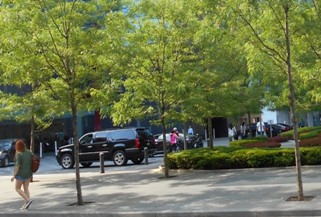Stormwater Tree Trenches
 Trees are critical element of a healthy urban environment. They help keep cities cool, sequester carbon, enhance air quality, manage stormwater, provide wildlife habitat and contribute to a sense of community well being. Recognizing the importance of trees, many municipalities have developed ambitious urban canopy programs and targets to help capture these benefits and create a more biodiverse and resilient urban environment. Unfortunately, the growth of street trees surrounded by pavements is often limited by compacted, low nutrient soils needed to prevent pavement slumping, heaving or cracking. While trees can survive under these conditions, they tend to be smaller, have shorter lives and require more maintenance than trees in the natural environment.
Trees are critical element of a healthy urban environment. They help keep cities cool, sequester carbon, enhance air quality, manage stormwater, provide wildlife habitat and contribute to a sense of community well being. Recognizing the importance of trees, many municipalities have developed ambitious urban canopy programs and targets to help capture these benefits and create a more biodiverse and resilient urban environment. Unfortunately, the growth of street trees surrounded by pavements is often limited by compacted, low nutrient soils needed to prevent pavement slumping, heaving or cracking. While trees can survive under these conditions, they tend to be smaller, have shorter lives and require more maintenance than trees in the natural environment.
Soil cells are designed to address this problem through underground, load bearing supported pavement systems filled with large volumes of uncompacted, nutrient rich soil. Large open spaces within the cells can easily accommodate utilities and drainage infrastructure and most modular units can be easily taken apart and re-assembled during emergency utility repairs. Configured in this way, soil cells are able to support large, healthy, long lasting trees.
Structural soils are also used to provide trees with increased rooting volume, nutrients and water. They typically contain a combination of open graded stone for structural support with up to 30% loam soil in the void spaces. In some cases, a soil stabilizer is added. While structural soils do not contain soils of similar volume and quality to that of soil cells, they are easier to install in non-uniform spaces constrained by utilities and have been shown to enhance tree growth relative to traditional tree trench configurations.
Both soil cells and structural soils can be used to improve stormwater management in urban environments by allowing runoff to drain through them. The soils and associated microbes filter and treat pollutants in runoff and much of the water falling on the tree or draining through it is infiltrated and returned to the atmosphere as evapotranspiration. Studies have shown that, with appropriate drainage infrastructure, trees can thrive when irrigated with road runoff, even when roads are salted in the winter. Not only do trees grow larger, but the extra runoff reduces the need for manual irrigation by providing a supplementary source of moisture. Results from local studies in Toronto and Peel Region clearly demonstrate the treatment and tree health benefits of combining stormwater with urban trees (see mene on the right for more on these studies).

